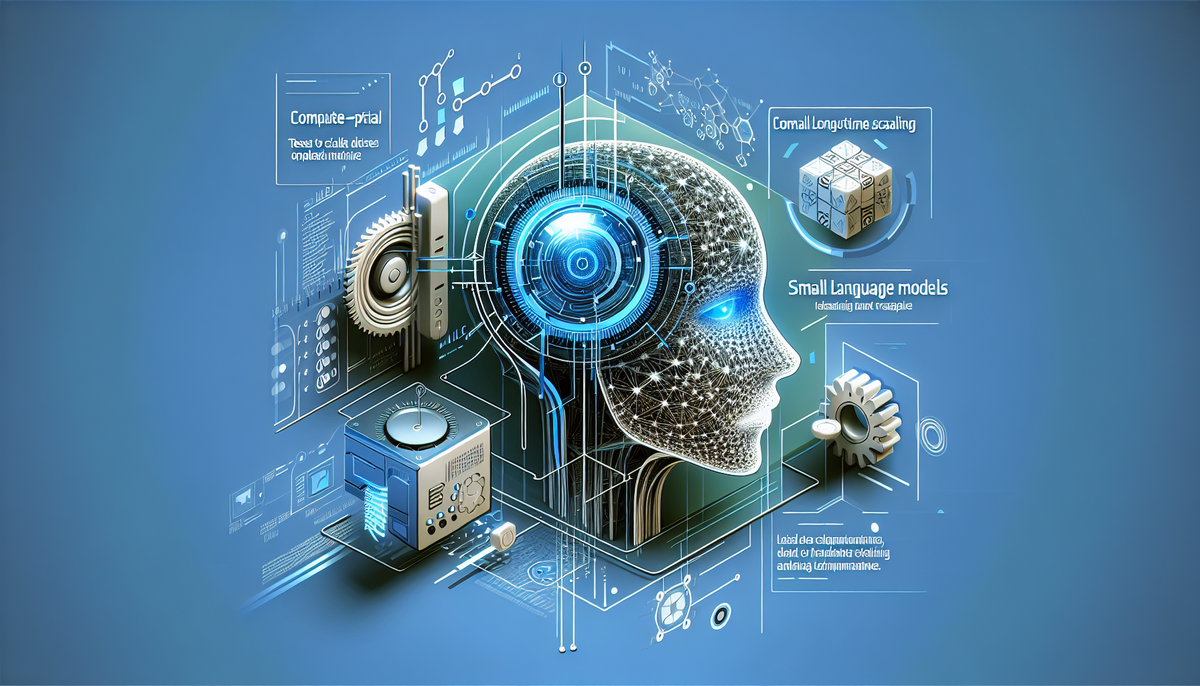Compute-Optimal TTS: Unlocking SLMs' Hidden Powers?

Introduction
Recent research from Shanghai AI Laboratory is revolutionizing our understanding of language model capabilities. A comprehensive study demonstrates that very small language models (SLMs) can outperform much larger LLMs on intricate reasoning tasks. Using compute-optimal test-time scaling (TTS), models with as few as 1 billion parameters have outmatched models with 405 billion parameters on high-level math benchmarks. This breakthrough is not only a technical feat but also a potential game-changer for enterprises seeking efficient and cost-effective AI solutions.
Understanding Test-Time Scaling (TTS)
Test-time scaling is an innovative process that enhances model performance during inference. Unlike traditional training methods that rely heavily on model size, TTS provides additional computational cycles after the model is fully trained. This extra compute is applied during the reasoning process:
- Internal TTS: Models are trained to generate extended chain-of-thought tokens, allowing them to reason slowly and comprehensively.
- External TTS: External helpers work alongside the primary model. Here, a policy model generates answers and a process reward model (PRM) evaluates them, selecting or refining the best responses.
These methods essentially provide a way to leverage additional compute without retraining the model. The result is a significant increase in the model’s ability to solve complex problems, especially in domains such as mathematics, coding, and even chemistry.
Technical Approaches in Test-Time Scaling
The study explores several external TTS setups that have distinct advantages based on model size and problem complexity. The main strategies include:
- Best-of-N: The policy model generates multiple candidate answers, and the PRM selects the best outcome. This approach is particularly effective for large models with robust inherent reasoning abilities.
- Beam Search: The model decomposes the answer into multiple steps, using a search process to select the best candidate at each stage. Beam search is preferable for small models tackling complex, multi-step problems.
- Diverse Verifier Tree Search (DVTS): Multiple branches of reasoning are explored to generate a diverse set of candidate responses, which are then synthesized into a final answer. This ensures that non-obvious solutions are not overlooked.
The choice of TTS strategy is highly dependent on the difficulty of the task and the intrinsic reasoning power of the model. For instance, SLMs with fewer than 7 billion parameters perform best with the best-of-N method for simpler tasks, while beam search and DVTS prove more advantageous for challenging problems.
SLMs Versus LLMs: The Performance Edge
The study reveals a surprising phenomenon: small language models, when combined with compute-optimal TTS methods, can outperform models that are exponentially larger. For example:
- A Llama-3.2-3B model, when enhanced with TTS, has been shown to outperform a Llama-3.1-405B model on rigorous math benchmarks such as MATH-500 and AIME-24.
- A Qwen2.5 model with only 500 million parameters has outperformed GPT-40 when leveraging appropriate test-time scaling strategies.
- A distilled version of DeepSeek-R1 with 1.5 billion parameters has also exceeded performance levels of more prominent models like o1-preview on similar complex reasoning tasks.
These results underscore the efficiency of TTS; with a fraction of the compute typically required by large language models, SLMs deliver superior performance in reasoning tasks. The findings suggest that for models with less inherent reasoning power, additional computational cycles at inference time can bridge or even surpass the gap created by larger parameter counts.
Scientific Insights and Methodologies
From a technical standpoint, the study highlights several key aspects of the TTS methodology:
- Policy and PRM Integration: The symbiotic relationship between the policy model and the PRM is central to achieving optimal performance. While the policy model generates potential answers, the PRM rigorously evaluates them, ensuring that the final output is both accurate and efficient.
- Problem Difficulty Adaptation: The efficiency of different TTS strategies is sensitive to the complexity of the task. Experiments indicate that beam search outperforms other methods for high-difficulty problems in smaller models, whereas the best-of-N approach suffices for simpler problems when dealing with larger models.
- Compute Budget Efficiency: An added benefit of using TTS is the dramatic reduction in computing resources. In some experiments, SLMs outperformed LLMs while using between 100 to 1000 times less Floating Point Operations Per Second (FLOPS). This efficiency is paramount for deployment in environments with restricted computing budgets, such as edge computing or mobile devices.
Existing literature, including studies published on platforms like ArXiv, underscores the potential of these methodologies in optimizing AI model performance. Industry leaders such as MIT Technology Review and IEEE have begun to discuss how such strategies could redefine the parameters of acceptable AI performance, particularly in resource-constrained settings.
Implications for Enterprise AI and Emerging Applications
The practical applications of compute-optimal TTS are vast and significant. Here are several ways enterprises could benefit:
- Cost Reduction: SLMs require significantly fewer computational resources for both training and inference, reducing costs and environmental impact.
- Scalability: The ability to deploy smaller models that can scale with additional test-time computation offers a flexible approach that adjusts to varying workload demands.
- Specialized Use Cases: Industries such as finance, healthcare, and logistics—where quick and precise reasoning is crucial—stand to gain from models that are tuned for efficiency over sheer size.
- Edge AI Applications: With lower compute requirements, SLMs can be deployed on edge devices, ensuring high performance without the need for constant cloud connectivity.
For enterprises, the shift towards more compute-efficient models means that state-of-the-art reasoning capabilities could become more accessible, enabling innovation even for organizations without extensive computational resources. This could be particularly transformative for startups and smaller companies looking to leverage AI for decision-making and automation.
Industry Insights and Expert Opinions
Analysts and researchers are particularly excited about the prospect of using TTS as a standard enhancement mechanism for AI reasoning tasks. During interviews with experts from IEEE and MIT Tech Review, key points emerged:
- Citation of Research: The study builds on previous research in neural network scaling and chain-of-thought processing, paving the way for more nuanced methods of model inference.
- Future Potential: Experts predict that as computation becomes cheaper and more accessible, test-time scaling may be integrated into a broader array of applications, including real-time analytics, autonomous decision-making, and even creative processes like automated storytelling.
- Challenges Ahead: While the results are promising, researchers caution that further studies are required to generalize these findings across diverse task domains, such as coding and chemical modeling.
To illustrate the impact further, consider the following case study:
Case Study: Small Models in a High-Stakes Environment
An international financial firm implemented a compute-optimal TTS strategy to bolster its risk assessment models. By integrating a small language model fine-tuned with external TTS techniques, the firm was able to generate highly accurate forecasts under volatile market conditions. The outcomes were twofold:
- The new model reduced inference times while improving prediction accuracy by 20% compared to its larger, resource-intensive counterpart.
- Operational costs dropped significantly, freeing up computational resources for other critical applications within the firm.
This case underscores the broader theme: performance improvements in AI are not solely a function of model size but also of innovative scaling strategies during inference.
Future Directions and Research Opportunities
The dynamic field of AI is continuously evolving, and compute-optimal TTS represents just one of many innovations pushing the boundaries of model efficiency. Future research directions include:
- Expansion to Other Domains: Researchers plan to investigate the applicability of TTS in areas beyond mathematics, such as automated coding, chemical structure analysis, and natural language understanding.
- Hybrid Scaling Models: Combining internal and external TTS strategies could yield even greater performance gains by leveraging the strengths of both methods.
- Energy Efficiency Measurements: Detailed studies on the energy savings from using SLMs with TTS can further promote sustainable AI practices by reducing overall compute demands.
As industry leaders and academic institutions like MIT and IEEE continue to explore these avenues, we can expect a new generation of AI systems that are not only more powerful but also far more efficient and adaptable.
Conclusion
The study from Shanghai AI Laboratory presents a compelling case for rethinking traditional assumptions about model size and performance. Compute-optimal test-time scaling has proven to unlock hidden reasoning abilities in small language models that enable them to outperform vastly larger counterparts. This paradigm shift is a significant step forward in making advanced AI technologies more accessible and cost-effective for a wide range of applications.
In summary, by leveraging strategic compute at inference time, enterprises can harness the power of smaller models to perform complex reasoning tasks with remarkable efficiency. As the technology matures and further research expands its applications, the potential for these techniques to revolutionize AI across multiple industries is immense.
For further reading and continuous updates on advanced AI techniques and emerging technologies, consider exploring dedicated resources from ArXiv, MIT Tech Review, and IEEE journals.



Comments ()